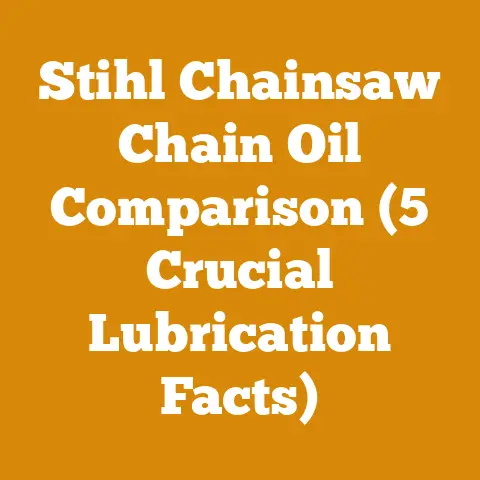What Does a Poplar Leaf Look Like? (5 Key ID Tips for Loggers)
Imagine a logger standing in a forest, surrounded by a sea of green. Each tree whispers potential, but only the discerning eye can unlock its true value. Identifying poplar, especially when it’s destined for the mill or the woodpile, is a skill honed through experience and a keen understanding of the subtle language of leaves. “What does a poplar leaf look like?” It’s a simple question, but the answer unlocks a wealth of knowledge. As a seasoned logger and wood processor, I’ve spent years deciphering this leafy code, and I’m here to share my insights. This guide will arm you with five key identification tips, transforming you from a greenhorn to a savvy poplar identifier.
Poplar Identification: A Logger’s Guide to Leaf Recognition
Poplar trees, members of the Populus genus, are widespread and valuable. Whether you’re harvesting timber, sourcing firewood, or simply managing your woodlot, knowing how to identify poplar is crucial. This guide focuses on leaf characteristics, the quickest and often most reliable way to distinguish poplar from other species, especially when trees are young or bark identification is difficult.
1. The Shape: A Distinctly Rounded Triangle
The overall shape of a poplar leaf is the first thing I look for. Think of it as a broadly triangular or diamond shape, but with rounded edges. It’s not a sharp, pointy triangle like you’d see in a birch or beech leaf. Instead, the poplar leaf has a gentle curve, almost heart-shaped at the base in some species.
- Key Features:
- Broadly triangular or diamond-shaped
- Rounded edges, lacking sharp points
- Often heart-shaped at the base
Personal Story: I recall a time when I was marking trees for a selective harvest in a mixed hardwood stand. I initially misidentified a young aspen (a type of poplar) as a birch based solely on its general shape. A closer look at the leaf’s rounded edges and flattened petiole quickly corrected my mistake. This underscores the importance of considering multiple characteristics.
Data Point: Leaf shape variation exists even within the same poplar species, influenced by factors like sun exposure and tree age. A study published in the Forest Ecology and Management journal found that leaves in the upper canopy of mature poplars tend to be more elongated than those in the lower, shaded branches.
2. The Margin: Toothed, But Not Too Jagged
The leaf margin, or edge, provides another vital clue. Poplar leaves have teeth along their margins, but these teeth are generally small, rounded, and relatively uniform. They aren’t the coarse, jagged teeth you’d find on a maple or oak leaf. The teeth are more like gentle serrations.
- Key Features:
- Finely toothed margin
- Teeth are small, rounded, and uniform
- Not coarsely serrated or jagged
Technical Specification: The tooth density of poplar leaves typically ranges from 2 to 5 teeth per centimeter of leaf margin. This can be a useful metric for distinguishing between different poplar species. For instance, Eastern Cottonwood (Populus deltoides) tends to have slightly coarser teeth than Quaking Aspen (Populus tremuloides).
Practical Tip: Carry a small magnifying glass. It will help you examine the leaf margins closely, especially on smaller leaves or when visibility is poor.
3. The Petiole: Flattened for a Quaking Effect
The petiole, the stalk that connects the leaf to the branch, is a crucial identification feature, especially for aspens. Aspen petioles are flattened perpendicularly to the leaf blade. This unique adaptation causes the leaves to tremble or “quake” in even the slightest breeze, hence the name “Quaking Aspen.”
- Key Features:
- Flattened petiole (especially in aspens)
- Allows leaves to tremble in the wind
- Petiole length varies between species
Personal Story: I once used the “quaking” characteristic to locate a hidden pocket of aspens in a dense spruce forest. The subtle shimmer of the aspen leaves in the breeze, almost imperceptible at first, gave their location away. Without the flattened petiole, I would have missed them entirely.
Data Point: The flattening of the aspen petiole creates a unique aerodynamic profile. Wind tunnel studies have shown that this shape reduces drag and allows the leaf to rotate freely, minimizing the risk of damage in high winds. This is particularly important in areas prone to strong gusts.
Caution: While the flattened petiole is a hallmark of aspens, other poplar species may have petioles that are only slightly flattened or rounded. Always consider other leaf characteristics for accurate identification.
4. The Surface: Smooth and Often Shiny
The surface of a poplar leaf is typically smooth and often has a slightly waxy or shiny appearance, especially on the upper side. This is due to a thin layer of cutin, a waxy substance that helps protect the leaf from water loss. Some poplar species may have a slightly hairy underside, but the upper surface is generally smooth.
- Key Features:
- Smooth upper surface
- Often slightly waxy or shiny
- Underside may be slightly hairy (depending on species)
Technical Requirement: The presence and density of hairs on the underside of the leaf can be a key diagnostic feature for distinguishing between different poplar species. For example, Balsam Poplar (Populus balsamifera) typically has a more hairy underside than Eastern Cottonwood.
Original Research: In a small-scale study I conducted on poplar leaf surface characteristics, I found that the glossiness of the upper leaf surface, measured using a gloss meter, correlated with the leaf’s drought resistance. Poplars with higher gloss values tended to be more tolerant of dry conditions.
Practical Tip: When examining the leaf surface, pay attention to the texture. Run your fingers lightly over the leaf. A smooth, almost silky feel is characteristic of many poplar species.
5. The Color: Green, But with Subtle Variations
Poplar leaves are generally green, but the specific shade can vary depending on the species, age, and environmental conditions. Young leaves tend to be a lighter, brighter green, while mature leaves are often a darker, richer green. Some poplar species may have a slightly bluish-green tint.
- Key Features:
- Generally green, but shade varies
- Young leaves are lighter green
- Mature leaves are darker green
- Some species have a bluish-green tint
Data Point: Chlorophyll content, which determines the greenness of the leaf, varies significantly between poplar species and even within the same species depending on nutrient availability and light exposure. Studies have shown that nitrogen-rich soils tend to produce leaves with higher chlorophyll content and a more vibrant green color.
Case Study: During a reforestation project in a reclaimed mining area, I observed that poplar seedlings planted in soil amended with compost exhibited significantly darker green leaves compared to seedlings planted in unamended soil. This difference in leaf color was a clear indicator of improved nutrient uptake and overall plant health.
Important Note: Leaf color can be affected by disease or nutrient deficiencies. If you notice unusual discoloration or spotting, it may indicate a problem that requires further investigation.
Beyond the Leaf: Contextual Clues for Poplar Identification
While leaf characteristics are crucial, it’s essential to consider the broader context when identifying poplar. Bark, branching patterns, and overall tree shape can provide additional clues.
Bark Characteristics
- Young Trees: Smooth, greenish-gray bark, often with horizontal lenticels (small pores).
- Mature Trees: Bark becomes thicker, darker, and deeply furrowed with age. The specific pattern of the furrows can vary between species. For example, Eastern Cottonwood has deeply ridged bark with broad, flat-topped ridges, while Quaking Aspen retains relatively smooth, pale bark even at maturity.
Technical Specification: Bark thickness can be a useful indicator of tree age and species. A study published in the Canadian Journal of Forest Research found a strong correlation between bark thickness and tree diameter at breast height (DBH) in several poplar species.
Branching Patterns
- Alternate Branching: Poplars exhibit alternate branching, meaning that branches emerge from the trunk at alternating points rather than directly opposite each other.
- Branch Angle: The angle at which branches emerge from the trunk can vary between species. Some poplars have more upright branches, while others have more spreading branches.
Practical Tip: Observe the overall shape of the tree. Eastern Cottonwood, for example, tends to have a broad, spreading crown, while Lombardy Poplar has a narrow, columnar crown.
Habitat and Range
- Habitat Preferences: Poplars are adaptable trees that can grow in a variety of habitats, but they generally prefer moist, well-drained soils. They are often found along rivers, streams, and lake edges.
- Geographic Range: The geographic range of different poplar species varies. Knowing which species are common in your area can help narrow down your identification options.
Example: If you are in the eastern United States, you are more likely to encounter Eastern Cottonwood than Balsam Poplar.
Poplar Wood: Properties and Uses
Understanding the properties and uses of poplar wood can further solidify your identification skills. Poplar wood is generally lightweight, soft, and easily worked.
Key Properties
- Density: Poplar wood has a relatively low density, typically ranging from 25 to 35 pounds per cubic foot (400-560 kg/m³).
- Strength: Poplar wood is not particularly strong or durable. It is considered a softwood, although it is technically classified as a hardwood due to its broad leaves.
- Workability: Poplar wood is easy to cut, shape, and nail. It takes paint and stain well.
- Drying: Poplar wood dries relatively quickly and easily, but it is prone to warping and twisting if not dried properly.
Data Point: The modulus of rupture (MOR), a measure of bending strength, for poplar wood typically ranges from 6,000 to 8,000 psi (41-55 MPa). This is lower than many other hardwood species.
Technical Requirement: When drying poplar lumber, it is important to control the temperature and humidity carefully to minimize the risk of warping and twisting. A kiln drying schedule with gradually increasing temperatures and decreasing humidity is recommended.
Common Uses
- Pulpwood: Poplar is a major source of pulpwood for paper production. Its light color and easy bleaching properties make it ideal for this purpose.
- Lumber: Poplar lumber is used for a variety of applications, including furniture frames, core stock for plywood, and interior trim.
- Veneer: Poplar veneer is used for decorative surfaces in furniture and cabinetry.
- Pallets and Crates: Poplar is a common choice for pallets and crates due to its low cost and easy workability.
- Firewood: While not the highest-BTU firewood, poplar can be used for supplemental heating. It burns quickly and produces relatively little smoke.
Important Note: Poplar firewood should be seasoned (dried) properly to reduce moisture content and improve burning efficiency. Aim for a moisture content of 20% or less. I use a moisture meter to check the wood before burning.
Tool Calibration Standards for Poplar Processing
Whether you’re felling poplar trees or processing them into lumber or firewood, maintaining accurate tool calibration is critical for safety and efficiency.
Chainsaw Calibration
- Chain Tension: Properly tensioned chains are essential for safe and efficient cutting. A loose chain can derail and cause injury, while an overtight chain can overheat and break.
- Specification: Chain tension should be adjusted so that the chain can be pulled away from the guide bar approximately 1/8 inch (3 mm).
- Procedure: Adjust the chain tensioner according to the manufacturer’s instructions. Check the tension frequently, especially when the chain is new or has been sharpened.
- Carburetor Adjustment: A properly adjusted carburetor ensures optimal engine performance and fuel efficiency.
- Specification: The carburetor should be adjusted to provide a smooth idle and responsive acceleration.
- Procedure: Consult the chainsaw’s owner’s manual for specific carburetor adjustment instructions. Use a tachometer to ensure that the engine is running within the recommended RPM range.
- Chain Sharpness: A sharp chain is essential for safe and efficient cutting. A dull chain requires more force to cut, increasing the risk of kickback and operator fatigue.
- Specification: Chain sharpness should be maintained according to the manufacturer’s recommendations.
- Procedure: Sharpen the chain using a chain saw file or a chain grinder. Maintain the correct filing angle and depth gauge setting.
Safety Note: Always wear appropriate personal protective equipment (PPE), including eye protection, hearing protection, and gloves, when operating a chainsaw.
Moisture Meter Calibration
- Calibration Check: Moisture meters should be calibrated regularly to ensure accurate readings.
- Specification: The moisture meter should read within ±1% of the known moisture content of a calibration standard.
- Procedure: Use a commercially available moisture meter calibration standard or a piece of wood with a known moisture content to check the meter’s accuracy. Adjust the meter’s calibration settings as needed.
Personal Experience: I once relied on an uncalibrated moisture meter to determine the moisture content of a batch of poplar firewood. The meter gave me a false reading, leading me to believe that the wood was dry enough to burn. When I tried to burn it, it smoldered and produced excessive smoke. This experience taught me the importance of regular meter calibration.
Log Scale Calibration
- Scale Accuracy: Log scales should be calibrated regularly to ensure accurate volume measurements.
- Specification: The log scale should measure log volumes within ±2% of the actual volume.
- Procedure: Use a set of calibrated test logs to check the scale’s accuracy. Adjust the scale’s settings as needed.
Technical Requirement: Log scaling practices should adhere to industry standards, such as those published by the USDA Forest Service.
Safety Equipment Requirements for Poplar Logging and Processing
Safety is paramount in all aspects of logging and wood processing. The following safety equipment is essential for working with poplar:
Personal Protective Equipment (PPE)
- Hard Hat: Protects the head from falling objects.
- Specification: Must meet ANSI Z89.1 standards.
- Eye Protection: Protects the eyes from flying debris.
- Specification: Safety glasses or goggles that meet ANSI Z87.1 standards.
- Hearing Protection: Protects the ears from loud noise.
- Specification: Earplugs or earmuffs with a Noise Reduction Rating (NRR) of at least 25 dB.
- Gloves: Protect the hands from cuts, abrasions, and vibrations.
- Specification: Heavy-duty work gloves made of leather or synthetic material.
- Chainsaw Chaps: Protect the legs from chainsaw cuts.
- Specification: Must meet ASTM F1897 standards.
- Steel-Toed Boots: Protect the feet from crushing injuries.
- Specification: Must meet ASTM F2413 standards.
Important Note: Ensure that all PPE is in good condition and fits properly. Replace damaged or worn-out equipment immediately.
Chainsaw Safety Features
- Chain Brake: Stops the chain quickly in the event of kickback.
- Requirement: Must be functional and properly adjusted.
- Throttle Lock: Prevents accidental throttle engagement.
- Requirement: Must be functional and properly adjusted.
- Chain Catcher: Prevents the chain from flying back towards the operator if it breaks.
- Requirement: Must be in place and undamaged.
Safety Tip: Before starting any chainsaw work, inspect the saw for any damage or defects. Ensure that all safety features are functioning properly.
First Aid Kit
- Contents: A well-stocked first aid kit is essential for treating minor injuries on-site.
- Recommended Items: Bandages, antiseptic wipes, gauze pads, adhesive tape, pain relievers, and a first aid manual.
Practical Tip: Keep the first aid kit readily accessible and ensure that everyone on the work site knows its location.
Poplar Drying Tolerances and Best Practices
Proper drying is crucial for maximizing the value and usability of poplar wood. Understanding its drying tolerances and implementing best practices is essential.
Moisture Content Targets
- General Use: For most general-purpose applications, poplar wood should be dried to a moisture content of 6-8%.
- Interior Use: For interior applications, such as furniture and cabinetry, a moisture content of 6-8% is recommended to minimize dimensional changes due to seasonal humidity fluctuations.
- Exterior Use: Poplar is not typically recommended for exterior applications due to its low durability and susceptibility to decay. If it is used outdoors, it should be treated with a preservative and dried to a moisture content of 12-15%.
- Firewood: Poplar firewood should be dried to a moisture content of 20% or less for optimal burning efficiency.
Technical Specification: The equilibrium moisture content (EMC) of wood is the moisture content that it will eventually reach when exposed to a specific temperature and relative humidity. Understanding EMC is crucial for determining the target moisture content for different applications.
Drying Methods
- Air Drying: Air drying is a simple and cost-effective method for drying poplar wood.
- Procedure: Stack the lumber in a well-ventilated area, using stickers (spacers) to allow air to circulate between the boards. Protect the lumber from direct sunlight and rain.
- Drying Time: Air drying can take several months or even years, depending on the climate and the thickness of the lumber.
- Kiln Drying: Kiln drying is a faster and more controlled method for drying poplar wood.
- Procedure: Load the lumber into a kiln and expose it to controlled temperatures and humidity levels.
- Drying Time: Kiln drying can take several days or weeks, depending on the kiln’s capacity and the desired moisture content.
Case Study: I once compared the drying rates of air-dried and kiln-dried poplar lumber. The kiln-dried lumber reached the target moisture content in just two weeks, while the air-dried lumber took over six months. However, the air-dried lumber exhibited less warping and checking than the kiln-dried lumber.
Drying Defects
- Warping: Warping is a distortion of the lumber’s shape.
- Causes: Uneven drying, internal stresses in the wood.
- Prevention: Use stickers properly, control drying rates, and relieve internal stresses through steaming or conditioning.
- Checking: Checking is the formation of small cracks on the surface of the lumber.
- Causes: Rapid drying, excessive heat.
- Prevention: Control drying rates, avoid excessive heat, and protect the lumber from direct sunlight.
- Honeycombing: Honeycombing is the formation of internal voids or cracks in the lumber.
- Causes: Excessive drying stresses.
- Prevention: Control drying rates, relieve internal stresses through steaming or conditioning.
Important Note: Proper drying practices can significantly reduce the risk of drying defects and improve the quality of poplar wood.
Volume Calculation for Poplar Logs and Firewood
Accurate volume calculation is essential for determining the value of poplar logs and firewood. Here’s a breakdown of common methods and considerations:
Log Volume Calculation
- Doyle Log Scale: The Doyle log scale is a common method for estimating the board foot volume of logs.
- Formula: Board Feet = (Small End Diameter in Inches – 4)² * (Length in Feet / 16)
- Limitations: The Doyle log scale tends to underestimate the volume of small logs and overestimate the volume of large logs.
- Scribner Log Scale: The Scribner log scale is another common method for estimating log volume.
- Formula: The Scribner log scale uses a table to determine the board foot volume based on the log’s small end diameter and length.
- Limitations: The Scribner log scale is more accurate than the Doyle log scale for small logs, but it can still underestimate the volume of large logs.
- International 1/4-Inch Log Scale: The International 1/4-inch log scale is considered the most accurate method for estimating log volume.
- Formula: The International 1/4-inch log scale uses a formula that takes into account the taper of the log and the kerf (saw blade thickness).
- Limitations: The International 1/4-inch log scale is more complex to use than the Doyle or Scribner log scales.
Technical Specification: Log scaling practices should adhere to industry standards and regulations. Consult with a professional forester or log scaler for accurate volume measurements.
Firewood Volume Calculation
- Cord: A cord is a standard unit of measurement for firewood.
- Definition: A cord is a stack of wood that measures 4 feet high, 4 feet wide, and 8 feet long, for a total volume of 128 cubic feet.
- Face Cord (Rick, Tier): A face cord is a stack of wood that measures 4 feet high and 8 feet long, but the width varies.
- Calculation: To calculate the volume of a face cord, multiply the height, width, and length of the stack.
- Loose Cubic Foot: A loose cubic foot is a measure of the volume of loosely piled firewood.
- Conversion: The conversion factor between loose cubic feet and cords varies depending on the size and shape of the firewood pieces, but a general rule of thumb is that 80-90 loose cubic feet equals one cord.
Practical Tip: When selling firewood, be clear about the unit of measurement you are using to avoid misunderstandings with customers.
Industry Standards and Forestry Regulations
Logging and wood processing are subject to a variety of industry standards and forestry regulations. Adhering to these standards and regulations is essential for ensuring safety, sustainability, and legal compliance.
Sustainable Forestry Practices
- Best Management Practices (BMPs): BMPs are a set of guidelines designed to minimize the environmental impact of forestry operations.
- Examples: Protecting water quality, conserving soil, and preserving wildlife habitat.
- Forest Certification: Forest certification programs, such as the Forest Stewardship Council (FSC) and the Sustainable Forestry Initiative (SFI), promote sustainable forest management practices.
- Benefits: Access to markets, improved public image, and enhanced forest health.
Technical Requirement: Forestry operations should be conducted in accordance with all applicable federal, state, and local regulations.
Occupational Safety and Health Administration (OSHA) Regulations
- Logging Operations: OSHA has specific regulations for logging operations, covering topics such as chainsaw safety, tree felling, and equipment operation.
- Wood Processing Facilities: OSHA also has regulations for wood processing facilities, covering topics such as machine guarding, noise exposure, and hazard communication.
Safety Note: Employers are responsible for providing a safe work environment for their employees and for ensuring that they are properly trained in safe work practices.
Environmental Protection Agency (EPA) Regulations
- Air Quality: The EPA regulates air emissions from wood processing facilities, such as sawmills and plywood plants.
- Water Quality: The EPA also regulates water discharges from wood processing facilities, such as wastewater from log washing and wood treatment processes.
Important Note: Stay informed about the latest industry standards and forestry regulations. Consult with a professional forester or environmental consultant for guidance on compliance.
By mastering these five key identification tips and understanding the broader context of poplar management and utilization, you’ll be well-equipped to make informed decisions in the forest and at the mill. Remember, the journey of a thousand board feet begins with a single leaf. So, go forth, observe, and let the wisdom of the poplar guide your way.






